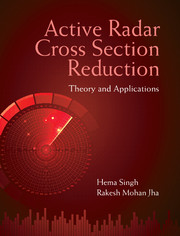Book contents
- Frontmatter
- Dedication
- Contents
- List of Tables
- List of Figures
- List of Abbreviations
- Preface
- Acknowledgements
- 1 Introduction to Radar Cross Section Reduction
- 2 RAM Analysis for Low-Observable Platforms
- 3 Radar Cross Section of Phased Antenna Arrays
- 4 Active RCS Reduction in Phased Arrays
- 5 Mutual Coupling Effects in Phased Arrays
- 6 RCS of Dipole Array Including Mutual Coupling Effects
- 7 Performance of Sidelobe Cancellers in Active RCSR
- 8 Emerging RCSR Techniques
- Epilogue
- Appendices
- List of Symbols
- Suggestions for Further Reading
- Author Index
- Subject Index
3 - Radar Cross Section of Phased Antenna Arrays
Published online by Cambridge University Press: 05 April 2015
- Frontmatter
- Dedication
- Contents
- List of Tables
- List of Figures
- List of Abbreviations
- Preface
- Acknowledgements
- 1 Introduction to Radar Cross Section Reduction
- 2 RAM Analysis for Low-Observable Platforms
- 3 Radar Cross Section of Phased Antenna Arrays
- 4 Active RCS Reduction in Phased Arrays
- 5 Mutual Coupling Effects in Phased Arrays
- 6 RCS of Dipole Array Including Mutual Coupling Effects
- 7 Performance of Sidelobe Cancellers in Active RCSR
- 8 Emerging RCSR Techniques
- Epilogue
- Appendices
- List of Symbols
- Suggestions for Further Reading
- Author Index
- Subject Index
Summary
Introduction
Radar cross section (RCS) is the measure of detectability of a target which, in turn, depends on its external features and electromagnetic (EM) properties. It relates the EM energy reflected from the target at the receiver to the incident EM energy coming out from the source. Alternately, it is the power scattered by the target towards an illuminator. The RCS of a target depends on its physical shape, frequency, polarisation properties, orientation, constitutive materials and subcomponents such as antennas and other sensors.
Phased antenna array is an array of antenna elements such as aperture, slot, horn, microstrip patch, spiral, dipole, etc. used to achieve high directivity (Mallioux 1994). It also affects the RCS of a platform on which it is mounted. Thus, for the estimation followed by reduction of RCS of a phased antenna array, scattering for both in-band (i.e. the operational frequency of radar signal) and out-of-band threat frequencies should be considered.
Scattering analysis of phased antenna arrays includes two scattering modes: antenna (or radiation mode) and structural mode (Hansen 1989). The antenna mode occurs when an induced current gets reflected at the antenna feed point and then re-radiated. On the contrary, the structural mode is generated from the antenna surface induced currents. The two modes are difficult to identify and separate, when the array is mounted on a platform (Wang et al. 2010). Further, the radiation and scattering characteristics of an antenna array depend on the relative operational frequency range of an antenna array with respect to that of the radar. If the frequency of the radar signal falls within the operating band of the antenna array, then the impinging signal will match that of antenna elements, and then it will penetrate into the feed structure. This signal results in multiple reflections within the antenna system and hence contributes significantly to RCS of the antenna array (Jenn 1995). of the impinging signal falls outside the operating band of the antenna array, then there will be no match between the radar signal and that of the antenna elements, and reflections inside the feed will be insignificant.
- Type
- Chapter
- Information
- Active Radar Cross Section ReductionTheory and Applications, pp. 65 - 125Publisher: Cambridge University PressPrint publication year: 2015



